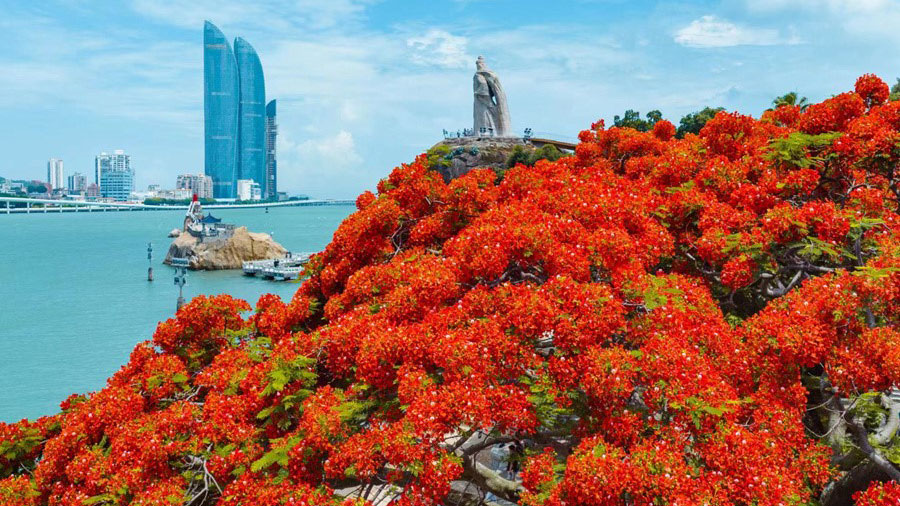Tibet implements rural revitalization strategy to accelerate development of border areas

This photo taken on June 11, 2023 shows houses at Yumai Township in Shannan City, southwest China's Tibet Autonomous Region. Located on the China-India border, Yumai Township was once known as China's least populated township. For a long period since the 1960s, it was inhabited by only one household consisting of Yangzom, Zhoigar and their father Sangye Quba, who passed away in 2001. Before Sangye Quba's death, he expressed his belief that the authority would develop Yumai well.
Nowadays, Sangye Quba's wish has been fulfilled. In February 2018, Tibet implemented the rural revitalization strategy, combining poverty alleviation and border defense with emphasis on key areas such as water and electricity supply, road construction, information networks, education, culture, health, and social security, striving to improve infrastructure and public services so as to accelerate the development of border areas.
Since 2018, Yumai Township has embarked on the construction of a prosperous border village with steel-framed houses, drainage, schools, and central parks popping up one after another. In 2019, a state investment of over 500 million yuan (about 69.8 million U.S. dollars) completed the reconstruction of the 50-kilometer paved road connecting Yumai to a neighboring township, which ended its pain of being snowbound every year. Additionally, the State Grid extended a 10-kilovolt power transmission line to Yumai, providing stable and secure electricity.
In 2022, the per capita annual income in Yumai reached nearly 44,000 yuan (about 6142.8 U.S. dollars) with a per capita residential area of 40 square meters. The once three-person township has transformed into a "well-off " one with two administrative villages under its jurisdiction. (Xinhua/Fei Maohua)
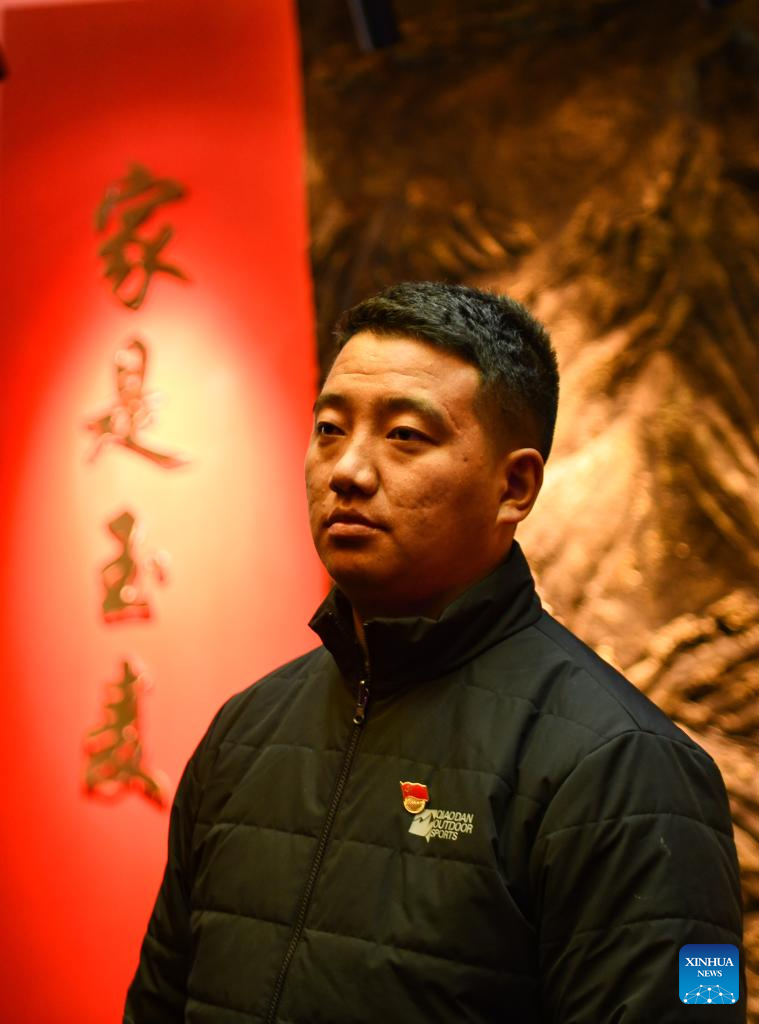
Soinam Toinzhub, the first university graduate of Yumai Township, is pictured in Shannan City, southwest China's Tibet Autonomous Region, June 10, 2023. Located on the China-India border, Yumai Township was once known as China's least populated township. For a long period since the 1960s, it was inhabited by only one household consisting of Yangzom, Zhoigar and their father Sangye Quba, who passed away in 2001. Before Sangye Quba's death, he expressed his belief that the authority would develop Yumai well.
Nowadays, Sangye Quba's wish has been fulfilled. In February 2018, Tibet implemented the rural revitalization strategy, combining poverty alleviation and border defense with emphasis on key areas such as water and electricity supply, road construction, information networks, education, culture, health, and social security, striving to improve infrastructure and public services so as to accelerate the development of border areas.
Since 2018, Yumai Township has embarked on the construction of a prosperous border village with steel-framed houses, drainage, schools, and central parks popping up one after another. In 2019, a state investment of over 500 million yuan (about 69.8 million U.S. dollars) completed the reconstruction of the 50-kilometer paved road connecting Yumai to a neighboring township, which ended its pain of being snowbound every year. Additionally, the State Grid extended a 10-kilovolt power transmission line to Yumai, providing stable and secure electricity.
In 2022, the per capita annual income in Yumai reached nearly 44,000 yuan (about 6142.8 U.S. dollars) with a per capita residential area of 40 square meters. The once three-person township has transformed into a "well-off " one with two administrative villages under its jurisdiction. (Xinhua/Jigme Dorji)
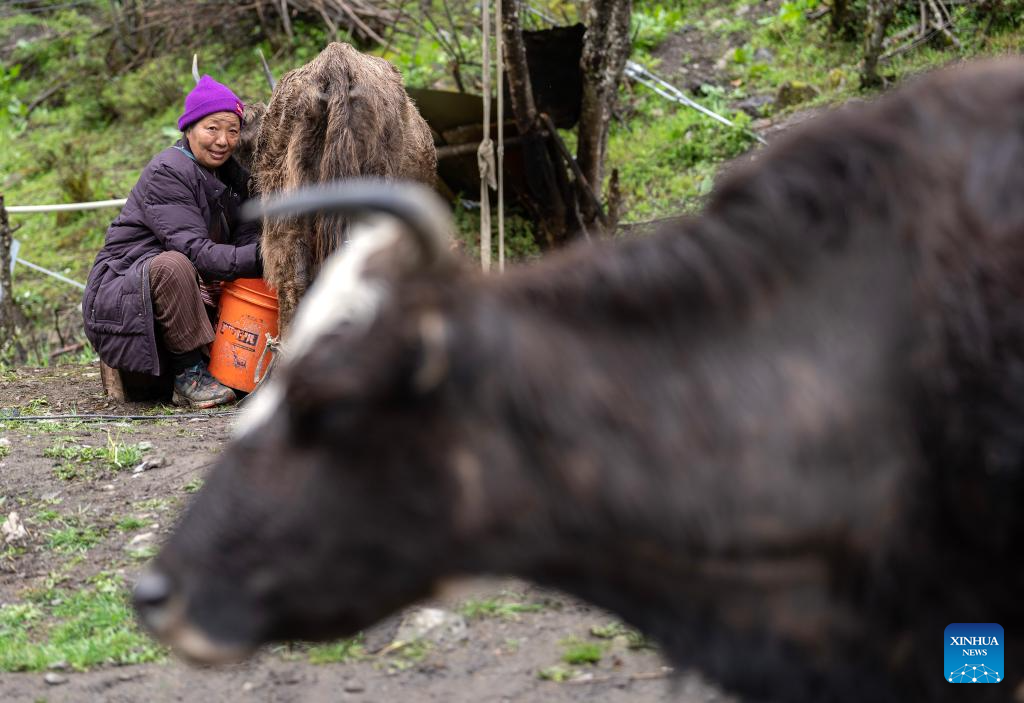
Yangzom milks at Yumai Township in Shannan City, southwest China's Tibet Autonomous Region, June 10, 2023. Located on the China-India border, Yumai Township was once known as China's least populated township. For a long period since the 1960s, it was inhabited by only one household consisting of Yangzom, Zhoigar and their father Sangye Quba, who passed away in 2001. Before Sangye Quba's death, he expressed his belief that the authority would develop Yumai well.
Nowadays, Sangye Quba's wish has been fulfilled. In February 2018, Tibet implemented the rural revitalization strategy, combining poverty alleviation and border defense with emphasis on key areas such as water and electricity supply, road construction, information networks, education, culture, health, and social security, striving to improve infrastructure and public services so as to accelerate the development of border areas.
Since 2018, Yumai Township has embarked on the construction of a prosperous border village with steel-framed houses, drainage, schools, and central parks popping up one after another. In 2019, a state investment of over 500 million yuan (about 69.8 million U.S. dollars) completed the reconstruction of the 50-kilometer paved road connecting Yumai to a neighboring township, which ended its pain of being snowbound every year. Additionally, the State Grid extended a 10-kilovolt power transmission line to Yumai, providing stable and secure electricity.
In 2022, the per capita annual income in Yumai reached nearly 44,000 yuan (about 6142.8 U.S. dollars) with a per capita residential area of 40 square meters. The once three-person township has transformed into a "well-off " one with two administrative villages under its jurisdiction. (Xinhua/Fei Maohua)

A staff member registers express parcels at a post office in Yumai Township in Shannan City, southwest China's Tibet Autonomous Region, June 10, 2023. Located on the China-India border, Yumai Township was once known as China's least populated township. For a long period since the 1960s, it was inhabited by only one household consisting of Yangzom, Zhoigar and their father Sangye Quba, who passed away in 2001. Before Sangye Quba's death, he expressed his belief that the authority would develop Yumai well.
Nowadays, Sangye Quba's wish has been fulfilled. In February 2018, Tibet implemented the rural revitalization strategy, combining poverty alleviation and border defense with emphasis on key areas such as water and electricity supply, road construction, information networks, education, culture, health, and social security, striving to improve infrastructure and public services so as to accelerate the development of border areas.
Since 2018, Yumai Township has embarked on the construction of a prosperous border village with steel-framed houses, drainage, schools, and central parks popping up one after another. In 2019, a state investment of over 500 million yuan (about 69.8 million U.S. dollars) completed the reconstruction of the 50-kilometer paved road connecting Yumai to a neighboring township, which ended its pain of being snowbound every year. Additionally, the State Grid extended a 10-kilovolt power transmission line to Yumai, providing stable and secure electricity.
In 2022, the per capita annual income in Yumai reached nearly 44,000 yuan (about 6142.8 U.S. dollars) with a per capita residential area of 40 square meters. The once three-person township has transformed into a "well-off " one with two administrative villages under its jurisdiction. (Xinhua/Jigme Dorji)

Yangzom milks at Yumai Township in Shannan City, southwest China's Tibet Autonomous Region, June 10, 2023. Located on the China-India border, Yumai Township was once known as China's least populated township. For a long period since the 1960s, it was inhabited by only one household consisting of Yangzom, Zhoigar and their father Sangye Quba, who passed away in 2001. Before Sangye Quba's death, he expressed his belief that the authority would develop Yumai well.
Nowadays, Sangye Quba's wish has been fulfilled. In February 2018, Tibet implemented the rural revitalization strategy, combining poverty alleviation and border defense with emphasis on key areas such as water and electricity supply, road construction, information networks, education, culture, health, and social security, striving to improve infrastructure and public services so as to accelerate the development of border areas.
Since 2018, Yumai Township has embarked on the construction of a prosperous border village with steel-framed houses, drainage, schools, and central parks popping up one after another. In 2019, a state investment of over 500 million yuan (about 69.8 million U.S. dollars) completed the reconstruction of the 50-kilometer paved road connecting Yumai to a neighboring township, which ended its pain of being snowbound every year. Additionally, the State Grid extended a 10-kilovolt power transmission line to Yumai, providing stable and secure electricity.
In 2022, the per capita annual income in Yumai reached nearly 44,000 yuan (about 6142.8 U.S. dollars) with a per capita residential area of 40 square meters. The once three-person township has transformed into a "well-off " one with two administrative villages under its jurisdiction. (Xinhua/Jigme Dorji)

Zhoigar (L) and Yangzom talk with people in a street at Yumai Township in Shannan City, southwest China's Tibet Autonomous Region, June 10, 2023. Located on the China-India border, Yumai Township was once known as China's least populated township. For a long period since the 1960s, it was inhabited by only one household consisting of Yangzom, Zhoigar and their father Sangye Quba, who passed away in 2001. Before Sangye Quba's death, he expressed his belief that the authority would develop Yumai well.
Nowadays, Sangye Quba's wish has been fulfilled. In February 2018, Tibet implemented the rural revitalization strategy, combining poverty alleviation and border defense with emphasis on key areas such as water and electricity supply, road construction, information networks, education, culture, health, and social security, striving to improve infrastructure and public services so as to accelerate the development of border areas.
Since 2018, Yumai Township has embarked on the construction of a prosperous border village with steel-framed houses, drainage, schools, and central parks popping up one after another. In 2019, a state investment of over 500 million yuan (about 69.8 million U.S. dollars) completed the reconstruction of the 50-kilometer paved road connecting Yumai to a neighboring township, which ended its pain of being snowbound every year. Additionally, the State Grid extended a 10-kilovolt power transmission line to Yumai, providing stable and secure electricity.
In 2022, the per capita annual income in Yumai reached nearly 44,000 yuan (about 6142.8 U.S. dollars) with a per capita residential area of 40 square meters. The once three-person township has transformed into a "well-off " one with two administrative villages under its jurisdiction. (Xinhua/Jigme Dorji)
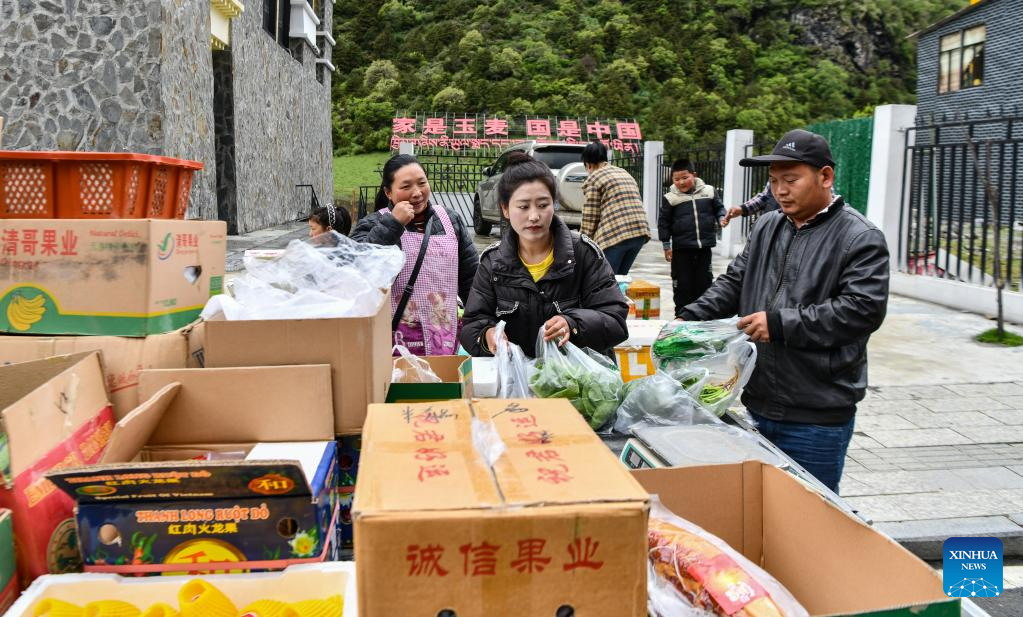
People buy fruit and vegetable at Yumai Township in Shannan City, southwest China's Tibet Autonomous Region, June 10, 2023. Located on the China-India border, Yumai Township was once known as China's least populated township. For a long period since the 1960s, it was inhabited by only one household consisting of Yangzom, Zhoigar and their father Sangye Quba, who passed away in 2001. Before Sangye Quba's death, he expressed his belief that the authority would develop Yumai well.
Nowadays, Sangye Quba's wish has been fulfilled. In February 2018, Tibet implemented the rural revitalization strategy, combining poverty alleviation and border defense with emphasis on key areas such as water and electricity supply, road construction, information networks, education, culture, health, and social security, striving to improve infrastructure and public services so as to accelerate the development of border areas.
Since 2018, Yumai Township has embarked on the construction of a prosperous border village with steel-framed houses, drainage, schools, and central parks popping up one after another. In 2019, a state investment of over 500 million yuan (about 69.8 million U.S. dollars) completed the reconstruction of the 50-kilometer paved road connecting Yumai to a neighboring township, which ended its pain of being snowbound every year. Additionally, the State Grid extended a 10-kilovolt power transmission line to Yumai, providing stable and secure electricity.
In 2022, the per capita annual income in Yumai reached nearly 44,000 yuan (about 6142.8 U.S. dollars) with a per capita residential area of 40 square meters. The once three-person township has transformed into a "well-off " one with two administrative villages under its jurisdiction. (Xinhua/Jigme Dorji)

Zhoigar (R) and Yangzom pose for a photo with the sculpture of their father Sangye Quba at Yumai Township in Shannan City, southwest China's Tibet Autonomous Region, June 10, 2023. Located on the China-India border, Yumai Township was once known as China's least populated township. For a long period since the 1960s, it was inhabited by only one household consisting of Yangzom, Zhoigar and their father Sangye Quba, who passed away in 2001. Before Sangye Quba's death, he expressed his belief that the authority would develop Yumai well.
Nowadays, Sangye Quba's wish has been fulfilled. In February 2018, Tibet implemented the rural revitalization strategy, combining poverty alleviation and border defense with emphasis on key areas such as water and electricity supply, road construction, information networks, education, culture, health, and social security, striving to improve infrastructure and public services so as to accelerate the development of border areas.
Since 2018, Yumai Township has embarked on the construction of a prosperous border village with steel-framed houses, drainage, schools, and central parks popping up one after another. In 2019, a state investment of over 500 million yuan (about 69.8 million U.S. dollars) completed the reconstruction of the 50-kilometer paved road connecting Yumai to a neighboring township, which ended its pain of being snowbound every year. Additionally, the State Grid extended a 10-kilovolt power transmission line to Yumai, providing stable and secure electricity.
In 2022, the per capita annual income in Yumai reached nearly 44,000 yuan (about 6142.8 U.S. dollars) with a per capita residential area of 40 square meters. The once three-person township has transformed into a "well-off " one with two administrative villages under its jurisdiction. (Xinhua/Fei Maohua)
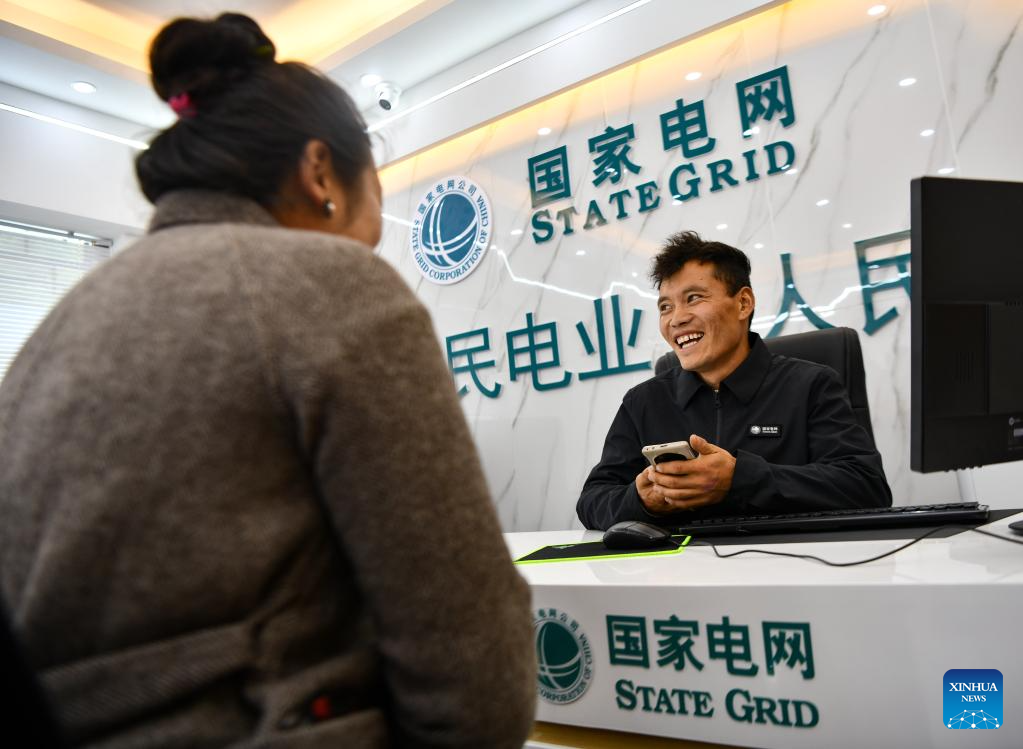
A staff member of State Grid helps a customer to pay electricity bill at Yumai Township in Shannan City, southwest China's Tibet Autonomous Region, June 10, 2023. Located on the China-India border, Yumai Township was once known as China's least populated township. For a long period since the 1960s, it was inhabited by only one household consisting of Yangzom, Zhoigar and their father Sangye Quba, who passed away in 2001. Before Sangye Quba's death, he expressed his belief that the authority would develop Yumai well.
Nowadays, Sangye Quba's wish has been fulfilled. In February 2018, Tibet implemented the rural revitalization strategy, combining poverty alleviation and border defense with emphasis on key areas such as water and electricity supply, road construction, information networks, education, culture, health, and social security, striving to improve infrastructure and public services so as to accelerate the development of border areas.
Since 2018, Yumai Township has embarked on the construction of a prosperous border village with steel-framed houses, drainage, schools, and central parks popping up one after another. In 2019, a state investment of over 500 million yuan (about 69.8 million U.S. dollars) completed the reconstruction of the 50-kilometer paved road connecting Yumai to a neighboring township, which ended its pain of being snowbound every year. Additionally, the State Grid extended a 10-kilovolt power transmission line to Yumai, providing stable and secure electricity.
In 2022, the per capita annual income in Yumai reached nearly 44,000 yuan (about 6142.8 U.S. dollars) with a per capita residential area of 40 square meters. The once three-person township has transformed into a "well-off " one with two administrative villages under its jurisdiction. (Xinhua/Jigme Dorji)

A child is pictured at Yumai Township in Shannan City, southwest China's Tibet Autonomous Region, June 10, 2023. Located on the China-India border, Yumai Township was once known as China's least populated township. For a long period since the 1960s, it was inhabited by only one household consisting of Yangzom, Zhoigar and their father Sangye Quba, who passed away in 2001. Before Sangye Quba's death, he expressed his belief that the authority would develop Yumai well.
Nowadays, Sangye Quba's wish has been fulfilled. In February 2018, Tibet implemented the rural revitalization strategy, combining poverty alleviation and border defense with emphasis on key areas such as water and electricity supply, road construction, information networks, education, culture, health, and social security, striving to improve infrastructure and public services so as to accelerate the development of border areas.
Since 2018, Yumai Township has embarked on the construction of a prosperous border village with steel-framed houses, drainage, schools, and central parks popping up one after another. In 2019, a state investment of over 500 million yuan (about 69.8 million U.S. dollars) completed the reconstruction of the 50-kilometer paved road connecting Yumai to a neighboring township, which ended its pain of being snowbound every year. Additionally, the State Grid extended a 10-kilovolt power transmission line to Yumai, providing stable and secure electricity.
In 2022, the per capita annual income in Yumai reached nearly 44,000 yuan (about 6142.8 U.S. dollars) with a per capita residential area of 40 square meters. The once three-person township has transformed into a "well-off " one with two administrative villages under its jurisdiction. (Xinhua/Jigme Dorji)

Zhoigar recalls her father at Yumai Township in Shannan City, southwest China's Tibet Autonomous Region, June 10, 2023. Located on the China-India border, Yumai Township was once known as China's least populated township. For a long period since the 1960s, it was inhabited by only one household consisting of Yangzom, Zhoigar and their father Sangye Quba, who passed away in 2001. Before Sangye Quba's death, he expressed his belief that the authority would develop Yumai well.
Nowadays, Sangye Quba's wish has been fulfilled. In February 2018, Tibet implemented the rural revitalization strategy, combining poverty alleviation and border defense with emphasis on key areas such as water and electricity supply, road construction, information networks, education, culture, health, and social security, striving to improve infrastructure and public services so as to accelerate the development of border areas.
Since 2018, Yumai Township has embarked on the construction of a prosperous border village with steel-framed houses, drainage, schools, and central parks popping up one after another. In 2019, a state investment of over 500 million yuan (about 69.8 million U.S. dollars) completed the reconstruction of the 50-kilometer paved road connecting Yumai to a neighboring township, which ended its pain of being snowbound every year. Additionally, the State Grid extended a 10-kilovolt power transmission line to Yumai, providing stable and secure electricity.
In 2022, the per capita annual income in Yumai reached nearly 44,000 yuan (about 6142.8 U.S. dollars) with a per capita residential area of 40 square meters. The once three-person township has transformed into a "well-off " one with two administrative villages under its jurisdiction. (Xinhua/Fei Maohua)
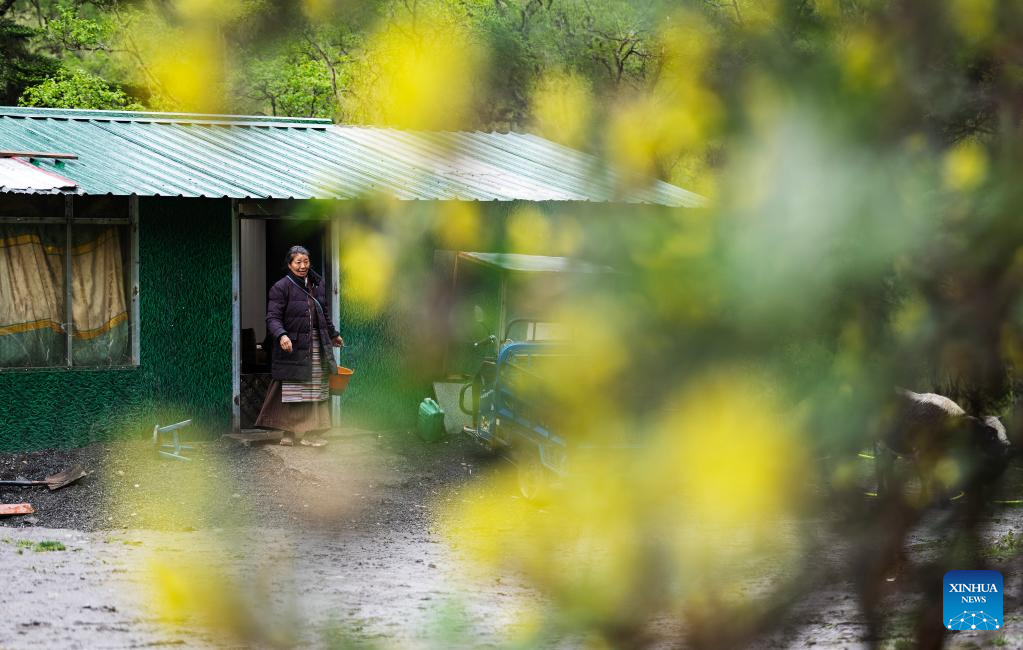
Yangzom walks out of the cabin to milk at Yumai Township in Shannan City, southwest China's Tibet Autonomous Region, June 10, 2023. Located on the China-India border, Yumai Township was once known as China's least populated township. For a long period since the 1960s, it was inhabited by only one household consisting of Yangzom, Zhoigar and their father Sangye Quba, who passed away in 2001. Before Sangye Quba's death, he expressed his belief that the authority would develop Yumai well.
Nowadays, Sangye Quba's wish has been fulfilled. In February 2018, Tibet implemented the rural revitalization strategy, combining poverty alleviation and border defense with emphasis on key areas such as water and electricity supply, road construction, information networks, education, culture, health, and social security, striving to improve infrastructure and public services so as to accelerate the development of border areas.
Since 2018, Yumai Township has embarked on the construction of a prosperous border village with steel-framed houses, drainage, schools, and central parks popping up one after another. In 2019, a state investment of over 500 million yuan (about 69.8 million U.S. dollars) completed the reconstruction of the 50-kilometer paved road connecting Yumai to a neighboring township, which ended its pain of being snowbound every year. Additionally, the State Grid extended a 10-kilovolt power transmission line to Yumai, providing stable and secure electricity.
In 2022, the per capita annual income in Yumai reached nearly 44,000 yuan (about 6142.8 U.S. dollars) with a per capita residential area of 40 square meters. The once three-person township has transformed into a "well-off " one with two administrative villages under its jurisdiction. (Xinhua/Fei Maohua)
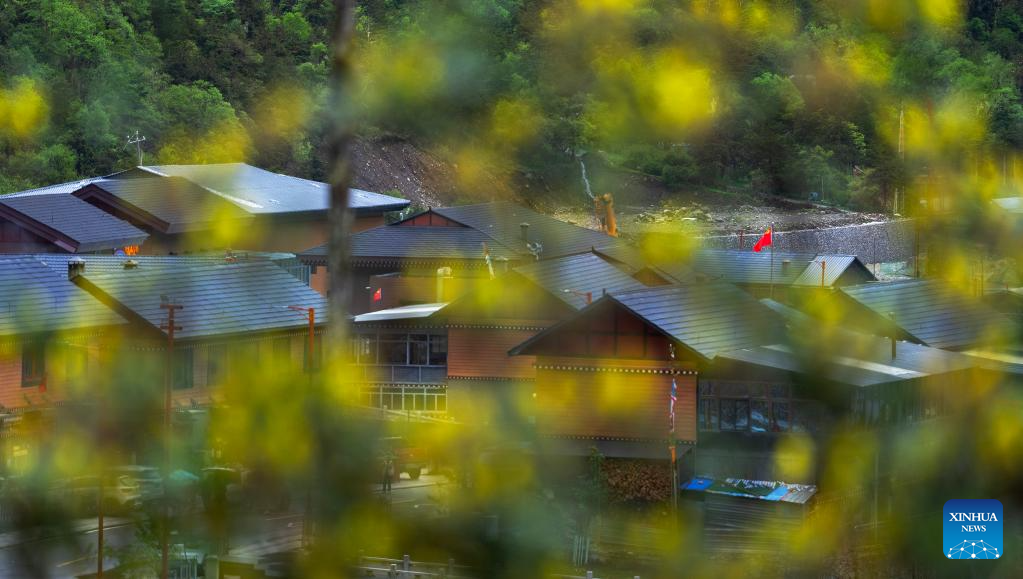
This photo taken on June 10, 2023 shows houses at Yumai Township in Shannan City, southwest China's Tibet Autonomous Region. Located on the China-India border, Yumai Township was once known as China's least populated township. For a long period since the 1960s, it was inhabited by only one household consisting of Yangzom, Zhoigar and their father Sangye Quba, who passed away in 2001. Before Sangye Quba's death, he expressed his belief that the authority would develop Yumai well.
Nowadays, Sangye Quba's wish has been fulfilled. In February 2018, Tibet implemented the rural revitalization strategy, combining poverty alleviation and border defense with emphasis on key areas such as water and electricity supply, road construction, information networks, education, culture, health, and social security, striving to improve infrastructure and public services so as to accelerate the development of border areas.
Since 2018, Yumai Township has embarked on the construction of a prosperous border village with steel-framed houses, drainage, schools, and central parks popping up one after another. In 2019, a state investment of over 500 million yuan (about 69.8 million U.S. dollars) completed the reconstruction of the 50-kilometer paved road connecting Yumai to a neighboring township, which ended its pain of being snowbound every year. Additionally, the State Grid extended a 10-kilovolt power transmission line to Yumai, providing stable and secure electricity.
In 2022, the per capita annual income in Yumai reached nearly 44,000 yuan (about 6142.8 U.S. dollars) with a per capita residential area of 40 square meters. The once three-person township has transformed into a "well-off " one with two administrative villages under its jurisdiction. (Xinhua/Fei Maohua)
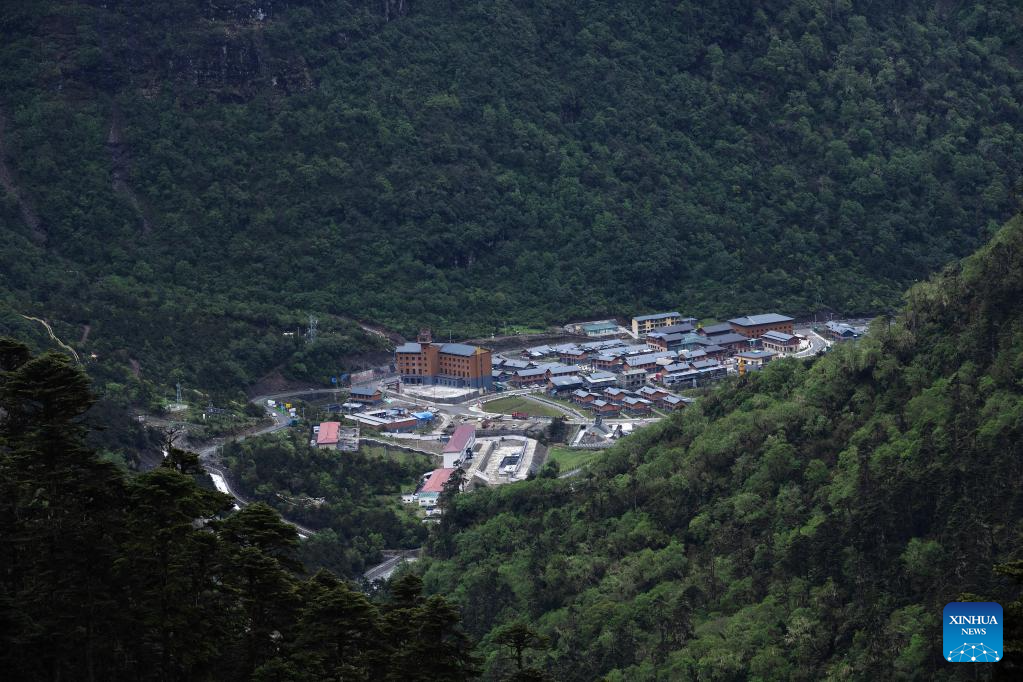
This aerial photo taken on June 11, 2023 shows Yumai Township in Shannan City, southwest China's Tibet Autonomous Region. Located on the China-India border, Yumai Township was once known as China's least populated township. For a long period since the 1960s, it was inhabited by only one household consisting of Yangzom, Zhoigar and their father Sangye Quba, who passed away in 2001. Before Sangye Quba's death, he expressed his belief that the authority would develop Yumai well.
Nowadays, Sangye Quba's wish has been fulfilled. In February 2018, Tibet implemented the rural revitalization strategy, combining poverty alleviation and border defense with emphasis on key areas such as water and electricity supply, road construction, information networks, education, culture, health, and social security, striving to improve infrastructure and public services so as to accelerate the development of border areas.
Since 2018, Yumai Township has embarked on the construction of a prosperous border village with steel-framed houses, drainage, schools, and central parks popping up one after another. In 2019, a state investment of over 500 million yuan (about 69.8 million U.S. dollars) completed the reconstruction of the 50-kilometer paved road connecting Yumai to a neighboring township, which ended its pain of being snowbound every year. Additionally, the State Grid extended a 10-kilovolt power transmission line to Yumai, providing stable and secure electricity.
In 2022, the per capita annual income in Yumai reached nearly 44,000 yuan (about 6142.8 U.S. dollars) with a per capita residential area of 40 square meters. The once three-person township has transformed into a "well-off " one with two administrative villages under its jurisdiction. (Xinhua/Fei Maohua)

This aerial photo taken on June 10, 2023 shows Yumai Township in Shannan City, southwest China's Tibet Autonomous Region. Located on the China-India border, Yumai Township was once known as China's least populated township. For a long period since the 1960s, it was inhabited by only one household consisting of Yangzom, Zhoigar and their father Sangye Quba, who passed away in 2001. Before Sangye Quba's death, he expressed his belief that the authority would develop Yumai well.
Nowadays, Sangye Quba's wish has been fulfilled. In February 2018, Tibet implemented the rural revitalization strategy, combining poverty alleviation and border defense with emphasis on key areas such as water and electricity supply, road construction, information networks, education, culture, health, and social security, striving to improve infrastructure and public services so as to accelerate the development of border areas.
Since 2018, Yumai Township has embarked on the construction of a prosperous border village with steel-framed houses, drainage, schools, and central parks popping up one after another. In 2019, a state investment of over 500 million yuan (about 69.8 million U.S. dollars) completed the reconstruction of the 50-kilometer paved road connecting Yumai to a neighboring township, which ended its pain of being snowbound every year. Additionally, the State Grid extended a 10-kilovolt power transmission line to Yumai, providing stable and secure electricity.
In 2022, the per capita annual income in Yumai reached nearly 44,000 yuan (about 6142.8 U.S. dollars) with a per capita residential area of 40 square meters. The once three-person township has transformed into a "well-off " one with two administrative villages under its jurisdiction. (Xinhua/Jigme Dorji)

Zhoigar makes butter at Yumai Township in Shannan City, southwest China's Tibet Autonomous Region, June 10, 2023. Located on the China-India border, Yumai Township was once known as China's least populated township. For a long period since the 1960s, it was inhabited by only one household consisting of Yangzom, Zhoigar and their father Sangye Quba, who passed away in 2001. Before Sangye Quba's death, he expressed his belief that the authority would develop Yumai well.
Nowadays, Sangye Quba's wish has been fulfilled. In February 2018, Tibet implemented the rural revitalization strategy, combining poverty alleviation and border defense with emphasis on key areas such as water and electricity supply, road construction, information networks, education, culture, health, and social security, striving to improve infrastructure and public services so as to accelerate the development of border areas.
Since 2018, Yumai Township has embarked on the construction of a prosperous border village with steel-framed houses, drainage, schools, and central parks popping up one after another. In 2019, a state investment of over 500 million yuan (about 69.8 million U.S. dollars) completed the reconstruction of the 50-kilometer paved road connecting Yumai to a neighboring township, which ended its pain of being snowbound every year. Additionally, the State Grid extended a 10-kilovolt power transmission line to Yumai, providing stable and secure electricity.
In 2022, the per capita annual income in Yumai reached nearly 44,000 yuan (about 6142.8 U.S. dollars) with a per capita residential area of 40 square meters. The once three-person township has transformed into a "well-off " one with two administrative villages under its jurisdiction. (Xinhua/Jigme Dorji)
Photos
Related Stories
- Tibet Story: Tibetan opera hits high notes among youngsters
- Cozy coffee house blends into Tibetan life
- Preserving the threatened art of saddlebag making
- Children in Tibet enjoy better education resources
- Tibetan craftsman repairs palm-leaf books to preserve old texts
- Internet helps drive rural revitalization in Xizang's Medog county
- China's Tibet saw stable, improved ecological environment in 2022
- Rare books on Tibetan epic published in China
- Pic story: border defense team in SW China's Tibet
- Gyaimaryangzhong Glacier in Tibet under ecological protection
Copyright © 2023 People's Daily Online. All Rights Reserved.









